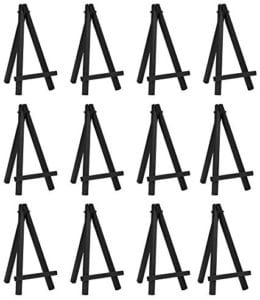I get a lot of questions about how well paint sticks to ceramic tiles, and shouldn’t I at least gesso the tile before pouring. You would think that was a good thing to do usually but I’ve found adding gesso or any other surface prep to non-porous surfaces has caused me problems in the past. In this video, I will look at how to prepare tiles for painting, and especially for acrylic pouring.

How to prepare tiles for acrylic pouring
Tiles are a great way to get started. They are easily available, affordable and easy to paint on, easy to clean if you don’t like the results. But the surfaces are glossy, so will the paint stick well enough for them to last well into the future? I am going to do a 3-way side-by-side pouring test to see if pouring works better with or without some kind or surface preparation for glossy ceramic tiles.
I’m using:
- a plain glossy tile that has only been cleaned and dried. No other prep.
- DecoArt Media Gesso
- DecoArt Americana Paint Adhesion Medium
We will see if we get better results with any of these options. On the tiles that were prepared, each was cleaned, then given a single generous coat of the gesso or medium and left to dry for 2-3 days before pouring (just because I got distracted by something else!)
Materials used in this experiment:
Glossy ceramic tiles
Assorted acrylic paints
DecoArt Paint Adhesion Medium
DecoArt Media Gesso
Floetrol
Treadmill silicone
Well there you have it. Both of those surface preps would be perfect for regular painting but even fully dry, they simply aren’t a match for the extended moisture that comes from acrylic pouring, where a thickness of wet paint is left on their surface for some time. The new paint softens and lifts the gesso or medium, causing it to come away from the glossy surface underneath and pucker. You can get some great texture in your paintings this way, but if that’s not what you want, then they are ruined.
On the other hand, the tile that didn’t have any preparation other than cleaning, turned out perfectly. So I stand by my assurances that it’s better to pour straight onto the tile than it is to use any kind of gesso etc. Just make sure that you allow the paint on the tile to fully dry all the way through, then apply several coats of a good sealer and I’m confident that paint will be stuck on there for good.
How to seal your tiles?
If using the tiles decoratively as mini-artworks, then I recommend the Polycrylic gloss finish. The tiles up to 6 inches look great on your desk or your mantle as mini-artworks. Use these cute little easels – they come in black or natural finish.
If you want to use your painted tiles for coasters, then you’ll need a water and heat proof finish. Here are the results of some previous testing and experiments with finishes and my recommendations for the best sealers.
Duplicolor Acrylic Enamel gloss spray finish
After being told in high school that she was so bad at art that she should switch to another subject, Deby didn’t paint again for 35 years. Then a stroke released a new wave of creativity and she began exploring with dot painting, abstract and eventually acrylic pouring, and at last the joy of working with color returned. You don’t need ‘talent’ to be an acrylic pouring artist – just enthusiasm, some basic instruction, and a willingness to try, fail and try again. Paint along with her and learn from her many mistakes, and you’ll soon make great art together.



I have very much enjoyed your vidio’s Deby and will miss you. Do keep well and if you ever come to Australia you would be welcome at our art group for a demo. I live on the Gold Coast.
Very sorry to hear your leaving us. We will all miss you. You’ve been a tremendous help to myself and everyone else. Stay well.
It seems the problem with the gesso or other media puckering is because it was fully dry, then gets wet again from the acrylic pour. What if you apply the gesso/medium, allow only the top of that surface to dry to the touch, then do the acrylic pour on top of that? Wouldn’t that get rid of the puckering problem? Would the gesso/medium help the acrylic stick to the tiles any better than the non-prepared tile surfaces?
Thank you for taking time to make vid. Good to see test results
Thank you so much for your videos, I cannot believe how I’ve been doing this , as I’m new to paint pouring, but with your help, I’m beginning to get good results.
I always prep my tiles with an acrylic paint primer & have never had any of the issues these had. I do use a base coat though so the paint has something to move over.